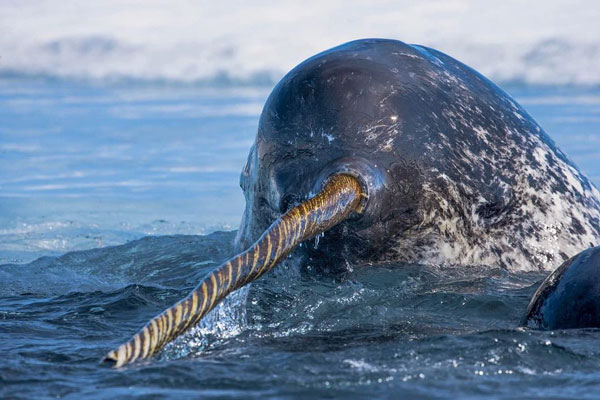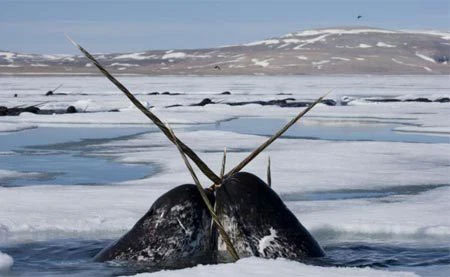The narwhal possesses treasures more precious than gold
The narwhal is a medium-sized marine animal of the suborder toothed whales. What makes this animal most noticeable is the distinctive long horn on its head.
Many movies and novels often feature a mythical creature known as a unicorn. In fact, there is also a creature with long horns on its head, which is the narwhal, the English name is "narwhal".

Along with the white whale, the narwhal is the only extant species of the family Monodontidae. However, white whales do not have horns like them. The narwhal lives in the frigid arctic region, where the weather conditions are harsh with thick layers of ice during the 6 months of winter.

What attracts the most attention to the narwhal is its unique long, straight horn. This is not actually a horn, but a fang that grows from the upper left jaw of the animal.

This tusk is usually 2 to 3m long, weighs more than 10kg and is only available to male narwhals. The fang grows in a counter-clockwise spiral, like the legendary unicorn horn.
Some narwhals even grow a pair of horns because the right canine also grows longer. However, the right tooth is usually shorter than the left and this is also extremely rare.

The narwhal's tusk does not play a big role in life. Females without long teeth live as long as males. Many other theories have been put forward about its uses such as breaking ice, sensing temperature, navigating or hunting. However, these theories have not really been proven.

According to Earthsky, it's simply a gender trait. Like a lion's mane or a male peacock's tail, narwhals use their long teeth to determine hierarchy and compete for females. However, scientists have not yet provided specific documents on this.
In the Middle Ages, it was believed that cutting the horns of a narwhal and grinding them into a powder could cure all ailments. Not only that, the horns of the narwhal are also used in many works of art. The throne of the king of Denmark in the 1600s was also decorated with narwhal teeth.

Today, their beauty and rarity are still hunted by the super-rich. Estimates of the price of narwhal tusks range from $4,000-15,700 and are often compared to gold. Queen Elizabeth I (1533-1603) once paid the equivalent of a castle to own rare narwhal tusks.

So, to make a profit, people have hunted and hunted narwhals a lot. Besides, this animal is affected by global warming. According to scientists, in 2008, there were an estimated 1,945 narwhals in the area, but by 2017 this number was only 246. This has a strong impact on the number of narwhals globally and makes the species worse. This creature is in danger of extinction in the near future.
- The case accidentally discovered ancient treasure under the sea
- Decipher the mysterious ivory of the narwhal
- Instructions on how to buy gold, distinguish real gold and fake gold
- Treasure of 20 tons of gold buried with 426 people in the US sea
- Please listen to the rare sounds created by the unicorn
- Find treasures in ancient garbage pits
- Gold is formed like?
- America: Found 8 jars of gold coins when walking the dog
- Interesting little things about gold
- Discover treasures invaluable 2,800 years old on mountains in Kazakhstan
- Discover treasures 2,000 years in 'ancient Titanic ship'
- Discover the secret from the gold store in Bulgaria
 Surprised: Fish that live in the dark ocean still see colors
Surprised: Fish that live in the dark ocean still see colors Japan suddenly caught the creature that caused the earthquake in the legend
Japan suddenly caught the creature that caused the earthquake in the legend A series of gray whale carcasses washed ashore on California's coast
A series of gray whale carcasses washed ashore on California's coast Compare the size of shark species in the world
Compare the size of shark species in the world